
The Scorpion Fish
Scorpaena scrofa
One of the venomous fishes found in Cretan waters, the scorpion fish is generally not a problem since it tends to hide
in amongst rocks and stones - making a sting from the spines down its back quite unlikely.
This fish is related to the well-known stone fish, but its venom is far less potent and does not normally cause serious
problems for human beings.
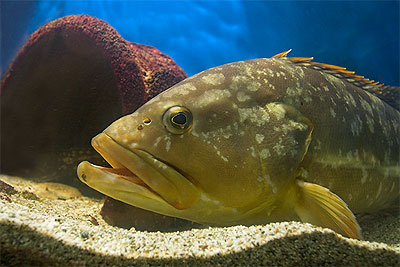
The Dusky Grouper
Epinephelus marginatus
Gertie the dusky grouper has been with us at Aquaworld since 2000, when she was rescued from a local fisherman's nets before
being made into soup!
She is about eight years old, and so is a female. She will become male around her twelfth birthday and will remain so for
the rest of her sixty year lifespan.

East Atlantic Peacock Wrasse
Symphodus tinca
The wrasses are some of the most colourful fishes in the Mediterranean and the peacock wrasse was one of the inspirations for the
creation of Aquaworld.
Male and female wrasses are often differently coloured and marked, but many of them can change sex as and when
necessary.
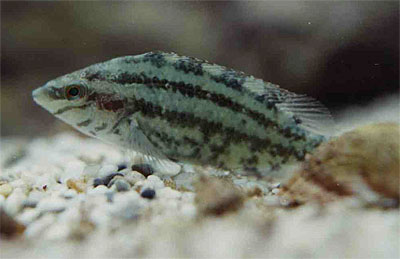
Five-spotted Wrasse
Symphodus roissali
The five-spotted wrasse is quite common in shallow, coastal waters. Like many of the wrasse family, colour and patterning and both
extremely variable and it is often difficult to establish the exact species.
At Aquaworld we always try to have a selection of these 'jewels of the sea' available for all to admire.

Conger Eel
Conger conger
Conger eels can become quite massive - perhaps 3m in length - with a set of teeth to match! Fortunately, they soon
become quite tame in an aquarium situation and rarely threaten to bite.
Like the moray eel below, congers are generally unwanted by-catch and are usually killed by wary fishermen. you can still
make out the scars from the fishing net on this one.
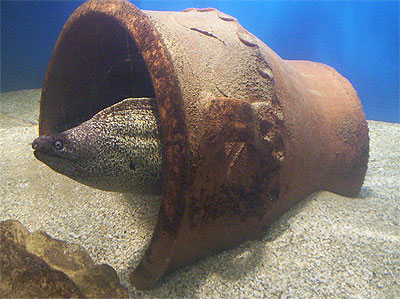
Moray Eel
Muraena helena
The local moray eel does not reach the same proportions as other species in the family. Lengths of about 1m are quite
common, although perhaps a maximum of 1.5m is possible.
People often believe that morays must be deep water dwellers but they can, in fact, be found in amongst rocks in very
shallow coastal areas.
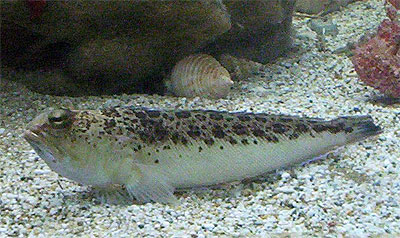
Starry Weever
Trachinus radiata
Another poisonous species, the weever fish can be a problem because it tends to bury itself in the sand where it lies
in wait for prey. The unsuspecting bather is then at risk of a bad sting by lowering a bare foot on the spines of its first
dorsal fin.
Although reportedly very painful, a weever fish sting is not normally a serious problem.

Common Stingray
Dasyatis pastinaca
The common stingray can reach a diameter of about 2.5m and the tail spines carry a potent venom. Stingrays are not,
however, aggressive in their use of poison - it is mainly for defensive purposes.
When approached, this ray will usually swim away and only the very unfortunate may step on them and receive a sting.

Rough Ray
Raja radula
This harmless little ray often appears in Cretan fishing nets. Considered inedible, they are often left to die and are discarded
when the nets are next used.
We often have a few brown rays on show at Aquaworld before they are released safe and sound back into their natural
habitat. Most have been rescued from nets.

Mediterranean Black Goby
Gobius niger
The gobies are particularly well represented in the shallow, coastal waters of Crete. As with the wrasses, they are often
difficult to tell one from another.
The black goby is a little easier than some others because of its distinctive high, pointed first dorsal fin and its
overall dark colouring.

Pearly Razorfish
Xyrichthys novacula
This is certainly one of the most distinctively shaped fishes to be found around Crete. With a very thin profile when
viewed head on, the razorfish has the most delicate pink and blue markings and little, sharp, protruding teeth.
Aquaworld visitors are often puzzled as to the whereabouts of the pearly razorfish, but the fact is that it spends long periods
totally buried under the sand.

Star-Gazer
Uranoscopus scaber
Another fish which spends a lot of its time buried in the sand is the star-gazer. It is perfectly adapted for this and
waits for long periods until something interesting chooses to swim past. When it does so, the star-gazer waves its tongue
about just above the surface of the sand. If the other fish makes the mistake of coming too close, up shoots the star-gazer
and grabs it in its gaping mouth.
Eat or be eaten - the rule of the sea!

Painted Comber
Serranus scriba
Another hunter is the painted comber. It is an ambush fish which often rests quietly under a rocky ledge, but is ready
to switch to full speed in an instant.
Local legend has it that, in order to catch an octopus for your dinner, you follow the eyes of the painted comber to find
one. There may be some truth in this, since any fish wanting to survive when there's an octopus around had better keep an
eye on it!

Damselfish
Chromis chromis
The damselfish is often seen in large schools in shallow water around Crete. Almost completely black when full-grown,
juveniles sport shiny blue patches on their heads.
Local fishermen often use damselfish as live bait, threading hooks through their backs and then allowing them to swim around
to attract larger predators such as fish of the mackerel family.
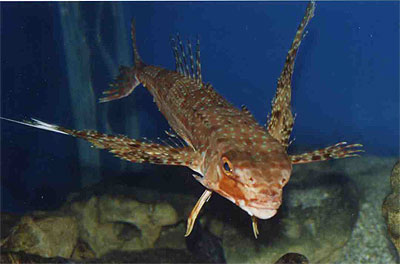
Flying Gurnard
Dactylopterus volitans
One of the most eye-catching of all local fishes, the flying gurnard is resplendent with its amazing wings with their brilliant
blue edgings. Its name would suggest that the fish uses these to fly, but this is not the case. The gurnard uses its wings
to try and scare other fish off when there's food around, or to try and 'line up' small prey items ready to grab them.
With its large, black eyes peering at you through the glass - it's hard to shake off the feeling that there's real
intelligence in there somewhere!
|




